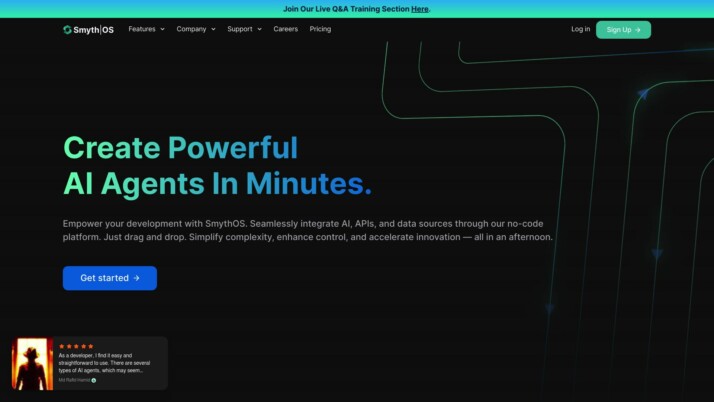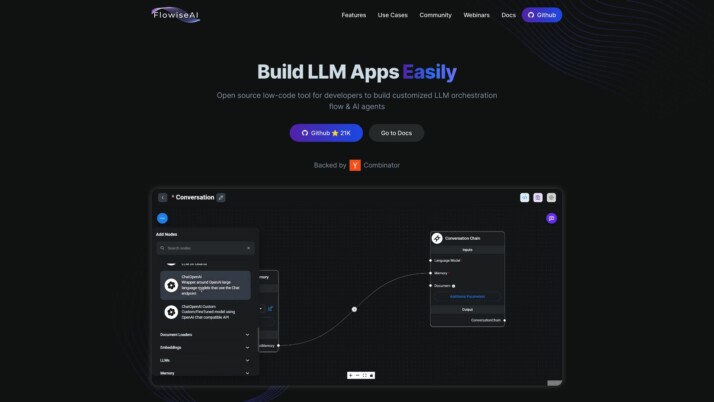SmythOS vs. FlowiseAI: Comprehensive Feature Comparison
As the AI industry continues to experience unprecedented growth and innovation, the demand for powerful yet accessible tools to harness the potential of this cutting-edge technology has never been greater. In this comprehensive review, we’ll explore two leading platforms, SmythOS vs. FlowiseAI, that empower users to create and deploy AI agents with ease.
Whether you’re a developer, business leader, or technology enthusiast, this guide will provide valuable insights into the unique features, capabilities, and use cases of each platform, enabling you to make an informed decision that aligns with your specific needs.
SmythOS Overview
SmythOS is a groundbreaking platform that revolutionizes the creation and deployment of AI agents. At its core, SmythOS offers an intuitive drag-and-drop interface, enabling users to build complex AI workflows without extensive coding knowledge. This democratizes AI development, making it accessible to a broader audience.


The platform stands out with its extensive integration ecosystem, supporting connection to a wide range of APIs, AI models, and tools from popular services like Slack, Trello, GitHub, and Stripe. This flexibility ensures that SmythOS can seamlessly fit into virtually any workflow or business process.
SmythOS provides pre-configured connectors and templates for common tasks, significantly reducing setup time and allowing users to focus on innovation.
Notably, SmythOS provides pre-configured connectors and templates for common tasks, significantly reducing setup time and allowing users to focus on innovation. Moreover, the multi-agent orchestration feature enables teams of AI agents to collaborate, enhancing efficiency and scalability.
One of SmythOS’s standout capabilities is its versatile deployment options. AI agents built on the platform can be deployed across various platforms like Google Vertex, Microsoft Copilot, AWS Bedrock, and even as ChatGPT plugins or Alexa skills. This ensures seamless integration into existing systems.
Overall, SmythOS has shipped a versatile AI operating system that empowers users to create, deploy, and manage AI agents quickly and efficiently. With its user-friendly interface and extensive library of components and templates, SmythOS aims to unleash an economic revolution by enabling businesses to automate mundane tasks, improve efficiency, and drive innovation across various industries.
FlowiseAI Overview
FlowiseAI is an open-source, low-code platform designed to empower developers in creating customized large language model (LLM) applications and AI agents. It streamlines the process of building sophisticated workflows that leverage the power of LLMs through an intuitive, visual interface.


One of the key strengths of FlowiseAI lies in its visual builder, which enables rapid prototyping and deployment of AI solutions without extensive coding expertise. Users can design complex LLM orchestration flows by connecting various nodes, such as document loaders, text splitters, vector databases, and LLMs, resulting in efficient and tailored AI workflows.
FlowiseAI’s versatility is further enhanced by its integration capabilities. It supports loading and processing various data formats, including PDFs, web pages, and text files, making it suitable for a wide range of applications such as document analysis, customer support, and content generation. Additionally, FlowiseAI allows for seamless integration with external vector databases like Pinecone, enabling efficient storage and retrieval of document embeddings.
Feature Comparison
SmythOS stands out with its comprehensive suite of features tailored for building and deploying AI agents efficiently. Its drag-and-drop visual builder, extensive integration ecosystem, and pre-built components streamline the development process, making AI accessible to a wide range of users.
One of SmythOS’s key advantages is its support for multi-agent collaboration, allowing teams of AI agents to work together seamlessly on complex tasks, enhancing scalability and efficiency.
In contrast, FlowiseAI, while offering a visual builder and support for various AI models, lacks some of the advanced features found in SmythOS. It does not provide hosted environments for development and production, nor does it offer robust debugging tools or support for multi-agent collaboration. Additionally, FlowiseAI’s deployment options are more limited, lacking features like staging domains or scheduled agent deployments.
While both platforms share some overlapping capabilities, such as support for APIs and webhooks, SmythOS’s extensive integration ecosystem, data lake support, and versatile deployment options give it a distinct edge in terms of flexibility and scalability. Furthermore, SmythOS’s commitment to security features like data encryption and OAuth integration ensures that AI agents built on the platform adhere to industry-standard security protocols.
It’s worth noting that FlowiseAI’s open-source nature may appeal to certain users seeking greater customization options. However, for enterprises, small businesses, and professionals seeking a comprehensive and user-friendly platform for building and deploying AI agents, SmythOS’s feature-rich offering positions it as a compelling choice.
Feature Comparison Table
| SmythOS | FlowiseAI | |
|---|---|---|
| CORE FEATURES | ||
| Hosted Agents | ✅ | ✅ |
| Environments (Dev, Production) | ✅ | ✅ |
| Debug Tools | ✅ | ✅ |
| Multi-Agent Collaboration | ✅ | ✅ |
| SECURITY | ||
| Constrained Alignment | ✅ | ✅ |
| OAuth | ✅ | ✅ |
| IP Control | ✅ | ❌ |
| COMPONENTS | ||
| Zapier APIs | ✅ | ✅ |
| Classifiers | ✅ | ✅ |
| DEPLOYMENT OPTIONS | ||
| Staging Domains | ✅ | ❌ |
| Deploy as Scheduled Agent | ✅ | ❌ |
| DATA LAKE SUPPORT | ||
| Hosted Vector Database | ✅ | ✅ |
| Sitemap Crawler | ✅ | ✅ |
Conclusion
In conclusion, SmythOS stands out as a comprehensive and user-friendly platform designed to revolutionize the way businesses and individuals create and deploy AI agents. With its intuitive drag-and-drop interface, extensive integration ecosystem, and versatile deployment options, SmythOS empowers users to harness the full potential of AI without requiring extensive coding expertise.
To experience the power of SmythOS firsthand, we invite you to explore our agent templates and sign up for a free account to get started.
One of the key advantages of SmythOS is its support for multi-agent collaboration, enabling teams of AI agents to work together seamlessly on complex tasks, enhancing efficiency and scalability. Additionally, SmythOS offers robust security features, including data encryption and OAuth integration, ensuring that AI agents built on the platform adhere to industry-standard security protocols.
To experience the power of SmythOS firsthand, we invite you to explore our agent templates and sign up for a free account to get started. With our comprehensive documentation and over 300,000 integrations, you can seamlessly integrate SmythOS into your existing workflows and deploy agents across various platforms, unlocking new levels of efficiency and innovation. Don’t just take our word for it – check out the glowing testimonials from our satisfied customers to see how SmythOS has transformed their businesses.
Last updated:
Disclaimer: The information presented in this article is for general informational purposes only and is provided as is. While we strive to keep the content up-to-date and accurate, we make no representations or warranties of any kind, express or implied, about the completeness, accuracy, reliability, suitability, or availability of the information contained in this article.
Any reliance you place on such information is strictly at your own risk. We reserve the right to make additions, deletions, or modifications to the contents of this article at any time without prior notice.
In no event will we be liable for any loss or damage including without limitation, indirect or consequential loss or damage, or any loss or damage whatsoever arising from loss of data, profits, or any other loss not specified herein arising out of, or in connection with, the use of this article.
Despite our best efforts, this article may contain oversights, errors, or omissions. If you notice any inaccuracies or have concerns about the content, please report them through our content feedback form. Your input helps us maintain the quality and reliability of our information.
